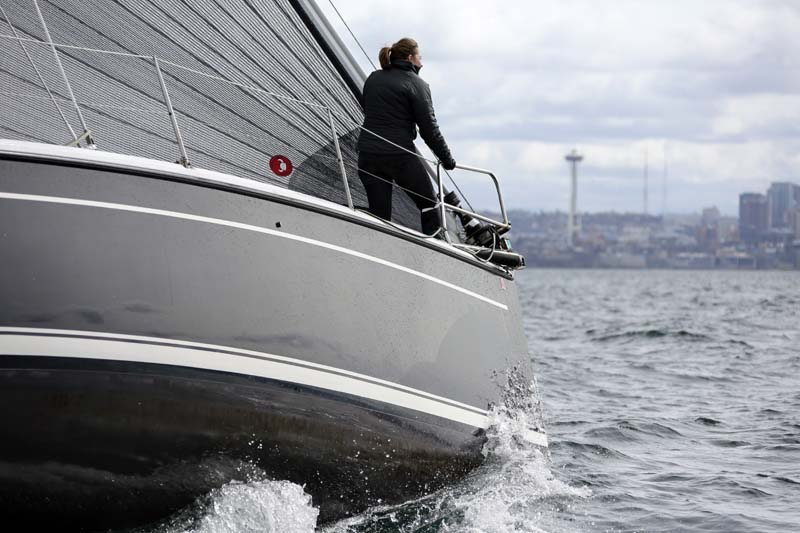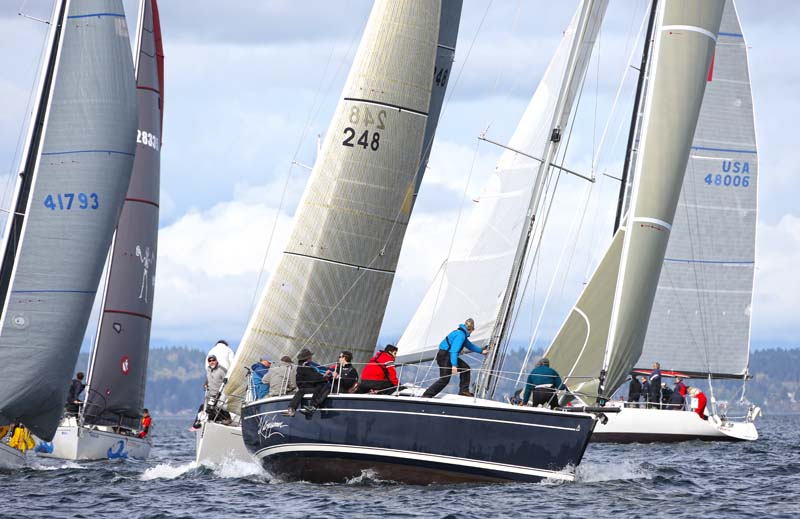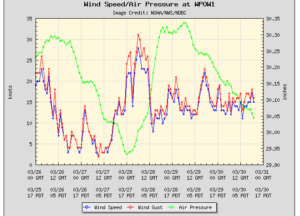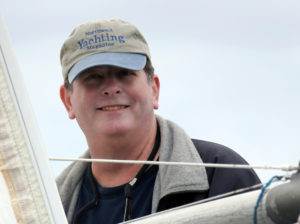WOW, what a great series and once again Mother Nature decided to be a bit of a contrarian. So what else is new? The Friday Brief had the conditions being predominantly post frontal and as you can see from the graph of conditions at West Point the front went through at around 1700 hrs on Friday, after which the barometer rose like crazy going from 29.94 to 30.33 at 1500 hrs on Saturday. The breeze velocity was really fairly steady over the course of the day until a few higher gusts came through just after 1700 hours on Saturday. All interesting information, however it was different than what we thought would happen on Friday.
On Saturday morning at 0700 hours when the first drones went out south of Alki the breeze was cranking out of the SW at almost 25 knots with dark, well defined puffs coming across the Sound out of Colvos and out of Rich Passage while the wind was lighter at West Point and more out of the SSW.
All photos by Jan Anderson. See the full gallery at her web site.












The first clue on Saturday morning that things were not really as forecast was the true wind direction in Shilshole the morning of the race. When it’s truly post-frontal the wind in the marina will be southerly instead it was out of the SSE coming right out of the Ship Canal. The warning lights went on then. Out in the starting area you were seeing a mag wind direction of 140° to 160°M and if you sailed out to the west the wind would clock around to 180° to 190°M. The tide was also ebbing early in the starting area so coming off the line near the boat end with clear air was a gain. The boats that were forced to tack to port and head out into the increasing ebb tide fell behind those that were able to go all the way into the breakwater and then tack. Those that were able to do that were able to lay West Point in one tack. They also got the port tack lifting puffs first, stayed out of the tide and generally made gains on those who went out early.
At West Point the ebb was rolling so it paid to hold port tack out into the Sound rather than tack immediately into Elliott Bay especially because with the wind NOT from the SW, port tack was very slightly favored. By about mid-Sound the ebb was almost neutral and you began to see a few of the early starting boats that had gone across the Sound to the Bainbridge shore where tacking on a very pronounced WSW breeze and going straight down the course on starboard tack. One big hint that this might work was that Dos the little Sierra 26 rocketship was over there and that is the boat’s home water.
From a line drawn due west from West Point to a line drawn due east from Restoration Point you had to play the shifts as they came through. It didn’t work to try and get over to west if you were sailing away from the mark. The reason was that the puffs from the WSW came in and worked their way across the Sound. So if you were sailing on port tack you needed to tack and sail south immediately. When the puff rolled through and you were headed on starboard you needed to tack back to port to get back in phase with the shifts. You headed west again until the next WSW puff came and then you tacked to starboard to find yourself high of the mark at TTP. Once you got through the transition zone into the area off of Rich Passage and the north end of Blake Island the breeze stayed out of the SW to WSW direction and it was time to hook up the barber hauler and start reaching holding a course about 10° high of TTP.
The boats that were west of the center of the Sound were able to reach all the way into TTP at well over hull speed while those to the east of the Sound had to take costly tacks to port to come off the beach and were headed 90 to the course.
Once around the mark it was a great ride on the southwesterly almost all the way home. The TP-52 Glory, first to finish and first overall in all three races, smoked around the 29.7 mile course in just under 3.5 hours averaging 8.56 knots. Glory was so far ahead we couldn’t tell if she was able to carry the kite as the wind went around to 220° to 230° and built to just over 20-knots. In those conditions she had to be just flying.
In the PHRF fleet it was the wickedly fast Terremoto that had the best elapsed time of 4.18 hours averaging 7.07 knots around the course and using that water ballast to advantage on the reach home. This also gave Terremoto the overall win in the Series. Overall winner in PHRF in the TTP Race and second overall for the Series was the Sierra 26 Dos which corrected out on the second overall boat the J-88 by almost five minutes on corrected time. This was interesting because the J-88 was able to carry their kite all the way to the finish while Dos decided to not risk another capsize and took their kite down so they could reach up and get back out into the middle of the Sound before setting the kite again so they had room to sail off in the puffs. Even with sailing that extra distance Dos still averaged 6.6 knots around the course and had a faster elapsed time than some much larger boats. As an example, first place in Division Six went to the C&C 115 Elusive who could only average 6.49 knots around the course.




